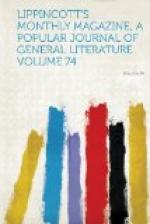When dinner was over, and only two stranded Belgians remained at table, discussing whether the Falls of Niagara plunge from the United States into Canada, or from Canada into the United States, I stole into the narrow office, believing I should see Francine.
She was not there, but the register was lying on the desk. I fell to turning the leaves over furiously: I felt that I was on the trail of Fortnoye. I was not long in amassing a quantity of discoveries. Going back to the previous year, I found the signature of Fortnoye in March and April; in July and September, Fortnoye bound up and down the Rhine; in the depth of the winter, Monsieur Tonson-Fortnoye come again! Evidently one of the most frequent guests of my delicate Francine was the interpreter of Cosmos in Strasburg, the white-bearded mystifier of the champagne-cellar, the finest singing-voice in Epernay.
[Illustration: The churchyard lover.]
Toward ten o’clock, as I paced the little grove called the Oak Wood, I saw at the miniature lake four persons, who were regaining the bank after trying to detach the little boat moored by the shore. They were just the four from our social table with whom I best agreed. I joined the party, and, hooking now a friendly arm to the elbow of one, now to that of another, I soon obtained all they had to communicate on the subject which occupied my mind. Each knew Fortnoye intimately: the result of my quadratic amounted to the following:
First. Fortnoye, educated at the Polytechnic School in Paris, is a man of grave character and profound learning.
Second. Fortnoye is a roysterer, latterly occupied in extending the connection of a champagne-house at Epernay. He is a Bohemian, even a poet: he can rhyme, but strictly in the interests of commerce—he composes only drinking-songs.
Third. Fortnoye is an exploded speculator, dismissed from the French Board: obliged to beat a retreat to Belgium, he soon found himself in Baden, where he had good luck at the green table shortly before the war.
Fourth, and last. (This was from the man of Wyoming.) Fortnoye only retreated to Belgium as a refuge for his demagogic opinions. He belongs to the innermost circle of the Commune and to all the French and Italian secret associations. He is represented in the background of several of Courbet’s pictures. He has been everywhere: in Italy he joined the society of the Mary Anne, where he met the celebrated Lothair. This order has a branch called the Society of Pure Illumination. If he has liberty to return into France, it is because he is connected with the detective police.
The information, extensive as it was, did not altogether satisfy me. I made little of the inconsistencies betrayed by the various counsels of the Areopagus, but I closed the whole solemnity with one crucial interrogatory: “What the dickens does Fortnoye come prowling around Francine Joliet’s house for?”




